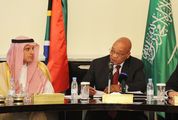LETTER FROM CHINA: Chinese plan to develop new reactors may benefit the world
by Kobus Van Der Wath,
2014-04-03 07:34:05.0
CHINA’s electricity usage and net oil imports (liquid fuel imports minus domestic production) are already at world-record levels, as questions regarding its energy security become more relevant considering its positive long-term growth outlook. It seems that China is answering the questions in several ways and two of them are with the development of thorium-fuelled and tidal-flow reactors.
While these sources of energy might not be the most significant in terms of current capacity and level of development, they present interesting findings as to the approach China is taking to diversifying its energy mix. Collaboration and investment in research and development by state and, increasingly, by private organisations are the key visible trends.
Thorium-fuelled reactors are, according to experts in the field, safer, more efficient and cleaner than other reactors in use. However, the faster development of uranium-fuelled reactors in the US and their ability to produce plutonium as a byproduct (used for nuclear warheads) meant they were preferred by the Nixon administration. As a result, the US shut down its thorium-fuelled reactors during the 1950s-1960s before their true potential could be reached on a large scale.
In order to get the project started, it required the son of former president Jiang Zemin to broker a co-operation agreement in 2010 between Oak Ridge, a lab belonging to the US department of energy, and the Chinese Academy of Sciences, a government body.
The deal included a transfer of the plans for the thorium reactor in exchange for the disclosure of all intellectual property arising from the joint venture to the international community. The minimal resistance experienced in the US is a result of the realisation that China developing this technology will benefit the world and the stringent restrictions placed on the research precludes it from being used for military projects.
The project, which is run from Shanghai by the Shanghai Institute of Nuclear and Applied Physics (Sinap), began in January last year with initial government funding of $350m. The goal is to build a fully functioning reactor by 2024, fifteen years ahead of Sinap’s initial estimates. Biannual visits by US scientists to share information on the project’s development are also part of the agreement.
With China already building over 28 nuclear reactors, thorium-fuelled ones will further reduce China’s dependence on imported oil fuels and polluting coal.
A different race for energy is transpiring, and it is happening in the ocean. While China lags behind Europe in sea-energy investments, it is closing the gap quickly. China has spent $160m since 2010 on energy from the sea while European countries have spent about $825m since 2006. However, in this instance, private enterprises instead of state-owned ones are driving the development.
Global players such as Atlantis Resources, Arcadis and even US defence contractor Lockheed Martin are forming joint ventures with Chinese companies to explore China’s coastline opportunities.
One of the numerous projects being explored has drawn in a consortium of eight Dutch companies. The Dynamic Tidal Power project is in its feasibility study stage and is estimated to cost about $30bn but could supply energy equivalent to two-and-a-half large nuclear reactors.
This project would be the largest of its kind and could produce electricity more cheaply than offshore wind farms, United Nations Industrial Development Organisation senior adviser for environment and climate change Dimitri de Boer says. He admits China is at the cutting edge of sea-energy technology development.
Chinese firms will undoubtedly use the transfer of technology from their partners, as well as their own development, to lead China into becoming the world’s leading installer of sea-energy capacity.
China’s efforts to diversify its energy mix away from coal and oil imports towards safer and more environmentally friendly sources will ensure it builds viable long-term energy security. In these efforts, private and state-owned enterprises are playing a role in developing cutting-edge technology.
• Van der Wath is group MD of The Beijing Axis. He can be reached at [email protected]
CHINA’s electricity usage and net oil imports (liquid fuel imports minus domestic production) are already at world-record levels, as questions regarding its energy security become more relevant considering its positive long-term growth outlook. It seems that China is answering the questions in several ways and two of them are with the development of thorium-fuelled and tidal-flow reactors.
While these sources of energy might not be the most significant in terms of current capacity and level of development, they present interesting findings as to the approach China is taking to diversifying its energy mix. Collaboration and investment in research and development by state and, increasingly, by private organisations are the key visible trends.
Thorium-fuelled reactors are, according to experts in the field, safer, more efficient and cleaner than other reactors in use. However, the faster development of uranium-fuelled reactors in the US and their ability to produce plutonium as a byproduct (used for nuclear warheads) meant they were preferred by the Nixon administration. As a result, the US shut down its thorium-fuelled reactors during the 1950s-1960s before their true potential could be reached on a large scale.
In order to get the project started, it required the son of former president Jiang Zemin to broker a co-operation agreement in 2010 between Oak Ridge, a lab belonging to the US department of energy, and the Chinese Academy of Sciences, a government body.
The deal included a transfer of the plans for the thorium reactor in exchange for the disclosure of all intellectual property arising from the joint venture to the international community. The minimal resistance experienced in the US is a result of the realisation that China developing this technology will benefit the world and the stringent restrictions placed on the research precludes it from being used for military projects.
The project, which is run from Shanghai by the Shanghai Institute of Nuclear and Applied Physics (Sinap), began in January last year with initial government funding of $350m. The goal is to build a fully functioning reactor by 2024, fifteen years ahead of Sinap’s initial estimates. Biannual visits by US scientists to share information on the project’s development are also part of the agreement.
With China already building over 28 nuclear reactors, thorium-fuelled ones will further reduce China’s dependence on imported oil fuels and polluting coal.
A different race for energy is transpiring, and it is happening in the ocean. While China lags behind Europe in sea-energy investments, it is closing the gap quickly. China has spent $160m since 2010 on energy from the sea while European countries have spent about $825m since 2006. However, in this instance, private enterprises instead of state-owned ones are driving the development.
Global players such as Atlantis Resources, Arcadis and even US defence contractor Lockheed Martin are forming joint ventures with Chinese companies to explore China’s coastline opportunities.
One of the numerous projects being explored has drawn in a consortium of eight Dutch companies. The Dynamic Tidal Power project is in its feasibility study stage and is estimated to cost about $30bn but could supply energy equivalent to two-and-a-half large nuclear reactors.
This project would be the largest of its kind and could produce electricity more cheaply than offshore wind farms, United Nations Industrial Development Organisation senior adviser for environment and climate change Dimitri de Boer says. He admits China is at the cutting edge of sea-energy technology development.
Chinese firms will undoubtedly use the transfer of technology from their partners, as well as their own development, to lead China into becoming the world’s leading installer of sea-energy capacity.
China’s efforts to diversify its energy mix away from coal and oil imports towards safer and more environmentally friendly sources will ensure it builds viable long-term energy security. In these efforts, private and state-owned enterprises are playing a role in developing cutting-edge technology.
• Van der Wath is group MD of The Beijing Axis. He can be reached at [email protected]




















Change: -0.47%
Change: -0.57%
Change: -1.76%
Change: -0.34%
Change: 0.02%
Data supplied by Profile Data
Change: -1.49%
Change: -0.04%
Change: -0.47%
Change: 0.00%
Change: 0.08%
Data supplied by Profile Data
Change: 0.16%
Change: 0.61%
Change: 0.12%
Change: -0.29%
Change: 0.82%
Data supplied by Profile Data
Change: 0.21%
Change: -0.42%
Change: 0.20%
Change: -1.22%
Change: -0.96%
Data supplied by Profile Data